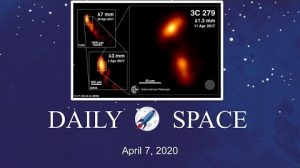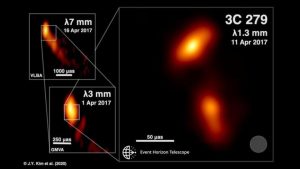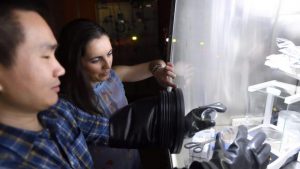
Observations of distant planets can be informed by the presence of sulfur, the Event Horizon Telescope gives us a fantastic photo of a black-hole powered jet inside a quasar, and Dr. Stuart Robbins joins us to discuss his climate research on Mars.
Links
First Event Horizon Telescope Images of a Black-Hole Powered Jet
- Something is Lurking in the Heart of Quasar 3C 279 (Max Planck Institute)
Sulfur can significantly impact observations of far-flung planets
- Sulfur ‘Spices’ Alien Atmospheres (Johns Hopkins)
Transcript
This is the Daily Space for today, Tuesday, April 7, 2020.
Welcome to the Daily Space, I am your host, Dr Pamela Gay, and I am here to put science in your brain. Most Mondays through Fridays either I or my co-host Annie Wilson will be here, bringing you a quick run down of all that is new in space and astronomy.
As promised, today we’re going to be joined by Dr Stuart Robbins, a Principal Research Scientist at SwRI, to talk about his latest research about Mars. As always, however, we’re going to start with today’s news.

The most exciting announcement was a surprise release from the Event Horizon Telescope. Last year they brought us a fabulous image of light twisting around the SMBH in the M87 Galaxy. Today they shared images of the Quasar 3C 279 that were taken in April 2017. With this significantly more distant system, their goal wasn’t to resolve the area around the galaxy’s black hole; instead they were simply using this distant source to calibrate their systems, and along the way they accomplished some cool science.
3C279 was discovered in 1973 to have superliminal jets, jets that thanks to their alignment toward and away from us and the time it takes light to travel, appear to be moving apart at faster than the speed of light. They aren’t, this is just a cool illusion. In EHT’s calibration images, the team was able to resolve features 20 micro arc-seconds thanks to the massive spread of their telescopes. This corresponded to features less than a light year across. By combining data from radio telescopes all across the planet, they synthesized a telescope the size of our planet. Over the several days of the teams observations, they could see details around the jets slowly change, presumably due to the rotation of the accretion disk around the black hole and the shredding and infall of material. Unexpectedly, in these super high resolution images they discovered the jets had an unexpected twist in their shape. This is super weird, and paper lead author Jae-Young Kim describes it this way: “Here, where we expected to find the region where the jet forms by going to the sharpest image possible, we fins a kind of perpendicular structure, This is like finding a very different shape by opening the smallest Matryoshka Doll.” What I particularly love about this is they discovered cool new science while just trying to calibrate their data on other sources, once again proving that one person’s trash is another person’s science. These results appear in the latest issue of Astronomy and Astrophysics.

Credit: Will Kirk/Johns Hopkins University
From the far off corners of the universe, we now jump to research about possible life right here in our own universe. One of the hottest topics in Exoplanet research right now is modelling planetary atmospheres and trying to sort what molecules may and may not signify the presence of life. In a new paper in the journal Nature, the Horst Lab at JHU explores the impact of sulphur. This element effects the chemistry of many worlds in our solar system, including Earth, Venus, and even Jupiter, and it plays an essential role in the chemistry of life, as an ingredient in several amino acids and enzymes. It is thought sulphur could play a role in the formation of life, and finding it in an alien atmosphere could point at a location for life.
According to lead author Chao He, “We found that just a small presence of sulfur in the atmosphere, less than 2%, can have major impacts on what, and how many, haze particles are formed. This entirely changes what scientists should look for and expect when they examine atmospheres on planets beyond our solar system.”
This is really cool research that involved simulating planetary atmospheres in a physical laboratory instead of just modelling things in software. There is a lot going on in this work, and we’re going to reach out to this team and see if they can come on to discuss this work on a future date.
For now, however, we have planetary scientist Stuart Robbins joining us to discuss new results appearing in JGR Planets that examines how Mars appearance changes year after year. This is ongoing work that includes reprocessing Mars images from the Mars Orbiter Camera to produce amazing and consistently processed images that allow us to understand variations in color and reflectivity over time.
<———————>
As part of helping keep us all occupied in these really weird times, we’re going to be hosting a lot of additional content on our Twitch channel, and we want to remind you that CosmoQuest has an active community on Discord where you can talk science, volunteer for various projects, and even find other people to join you in playing some online games. You can find links to everything that is going on at CosmoQuest.org.
Thank you all for listening. Today’s script was written by Pamela Gay, and the Daily Space is produced by Susie Murph. The Daily Space is a product of the Planetary Science Institute, a 501(c)3 non profit dedicated to exploring our Solar System and beyond. We are here thanks to the generous contributions of people like you. The best way you can support us is through Patreon.com/cosmoquestx Like us? Please share us! You never know whose life you can change by adding a daily dose of science.


 We record most shows live, on Twitch. Follow us today to get alerts when we go live.
We record most shows live, on Twitch. Follow us today to get alerts when we go live.